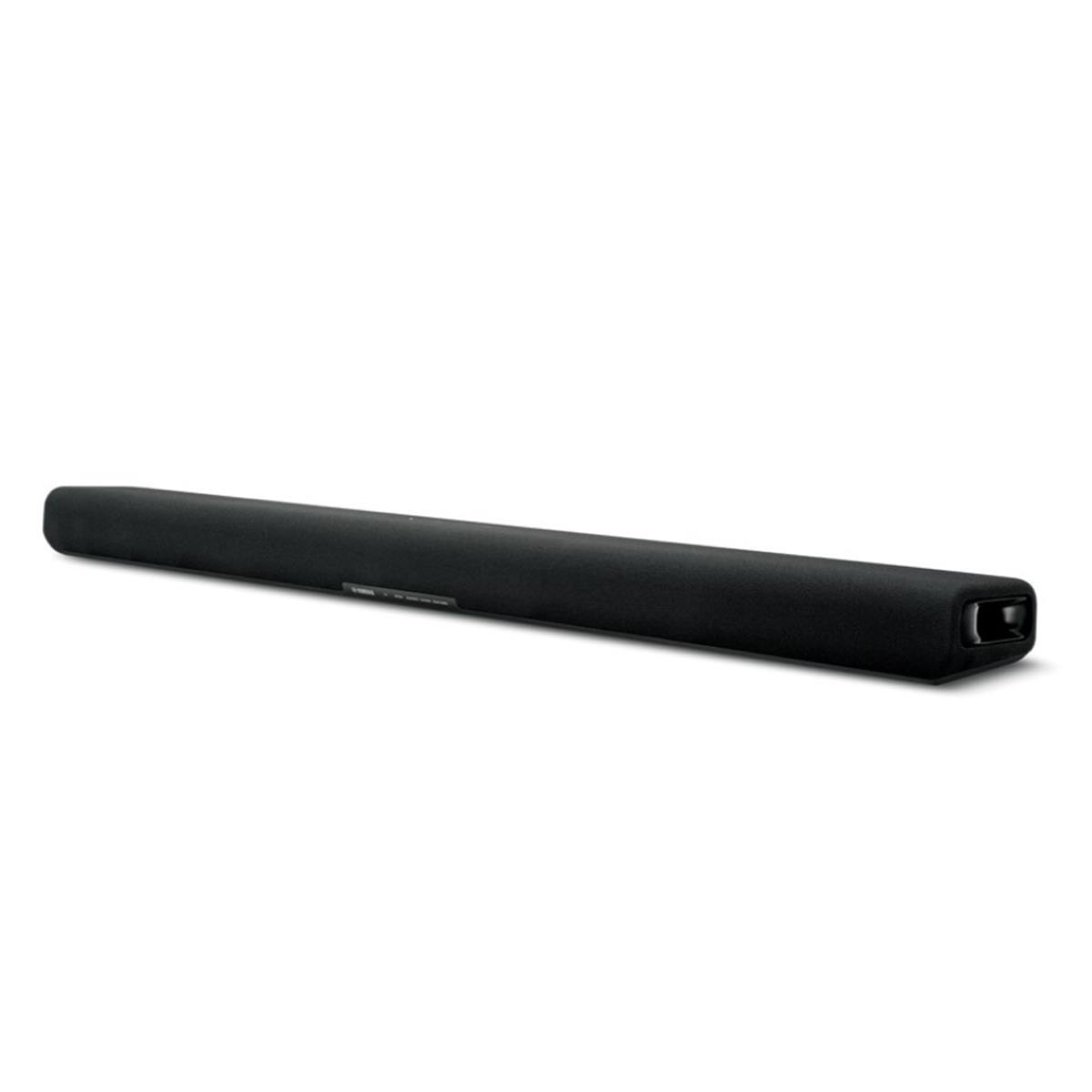 Yamaha SR-B30A Sound Bar with Built-In Subwoofers
Yamaha SR-B30A Sound Bar with Built-In Subwoofers





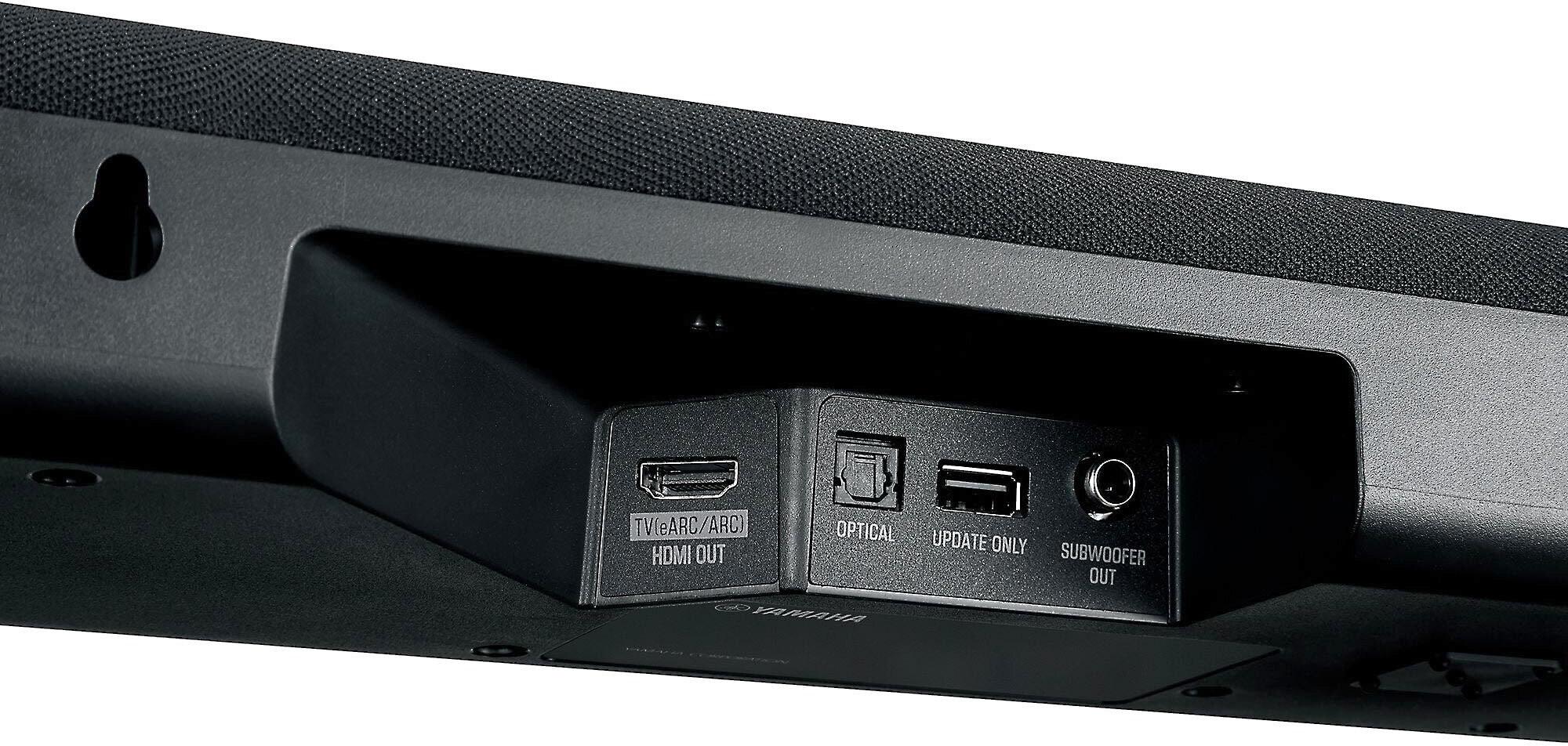
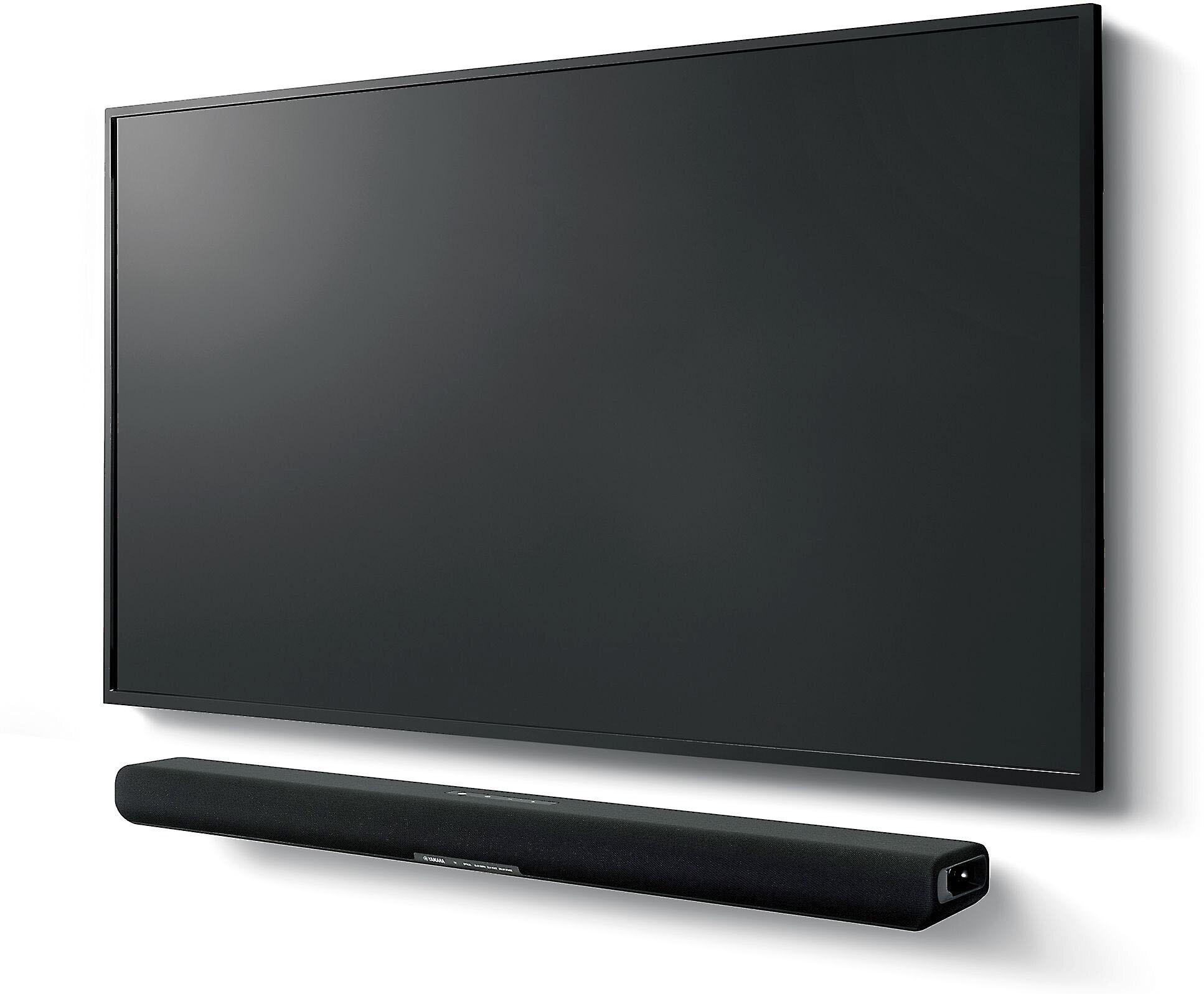
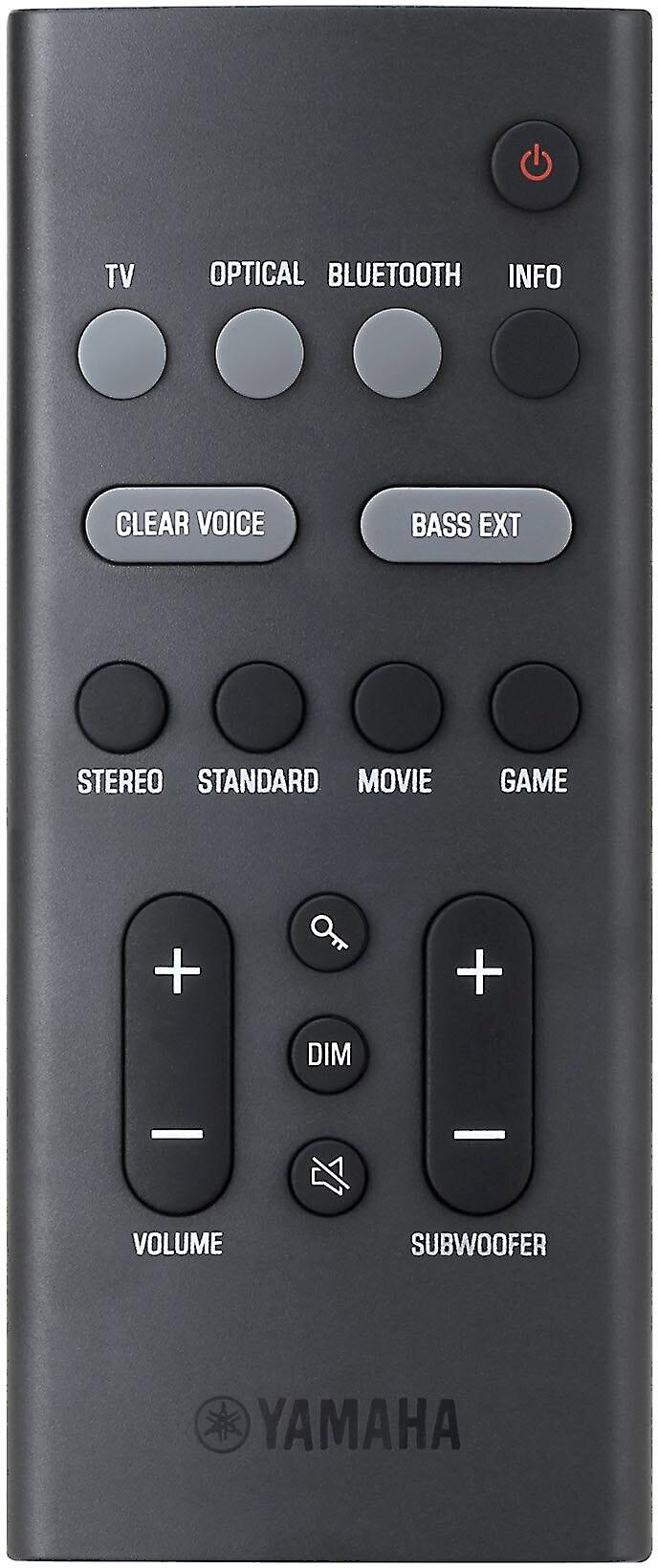
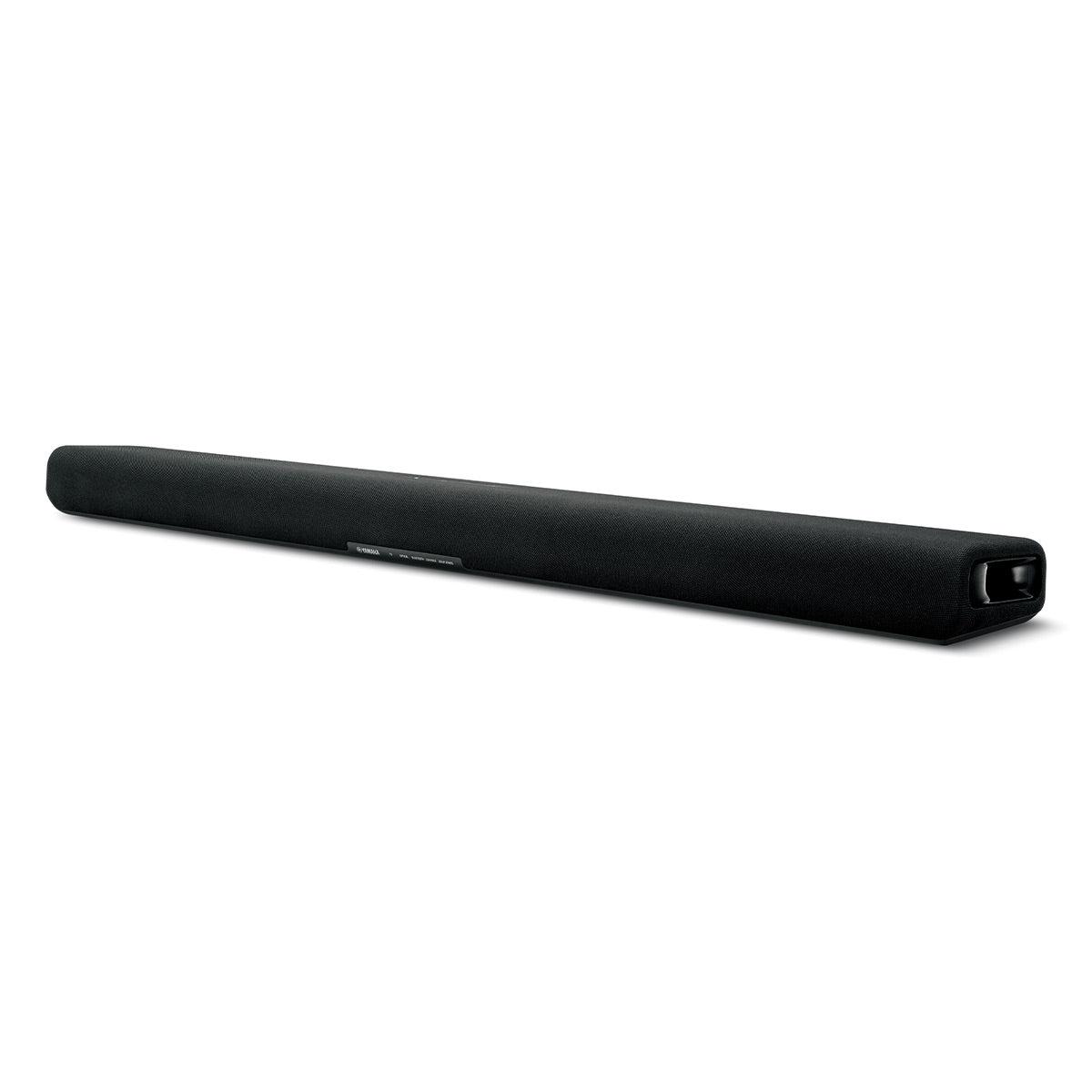
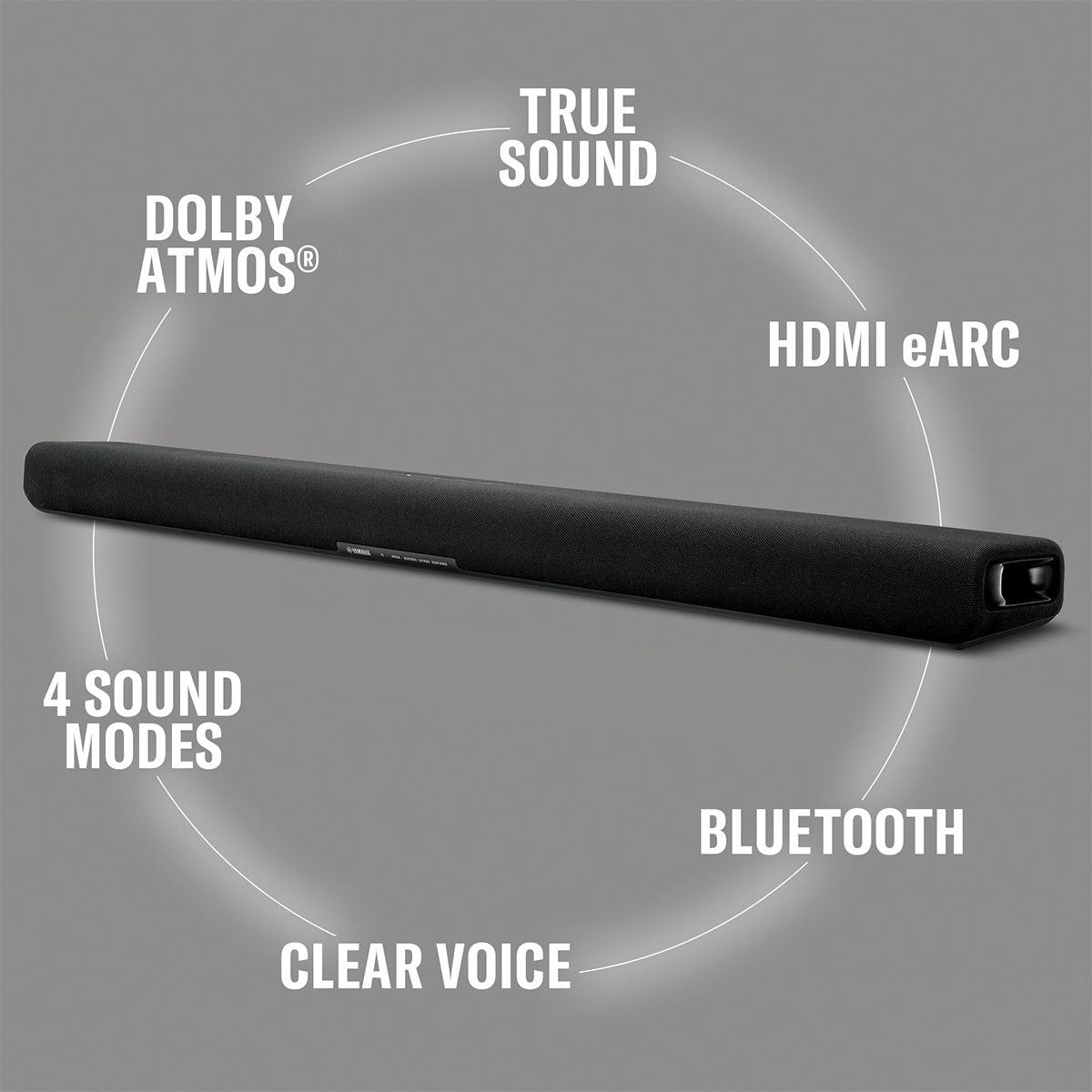

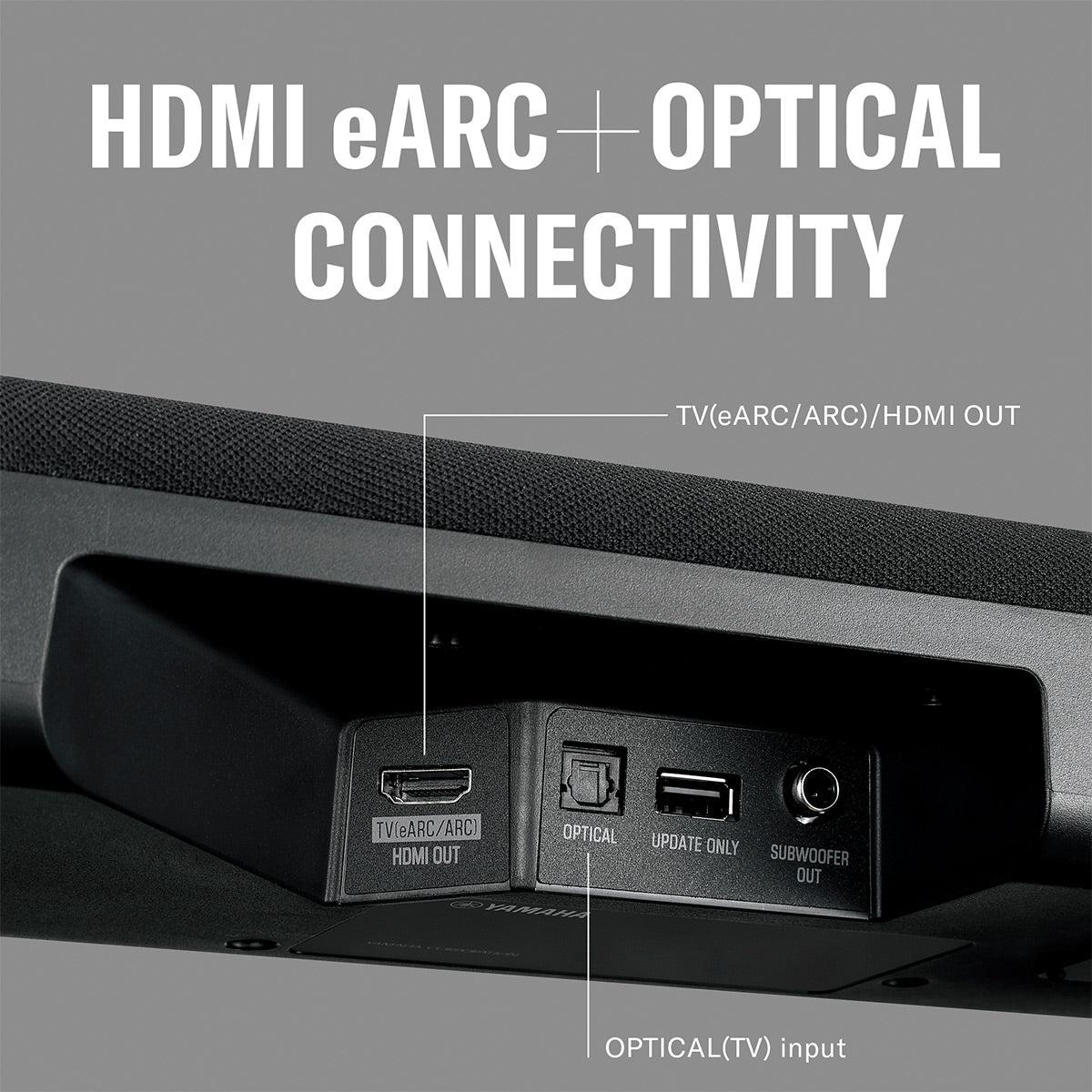












$279.95 Original price was: $279.95.$219.95Current price is: $219.95.
When Yamaha released the SR-B30A in late 2021, they aimed to solve a common problem: delivering quality home theater sound without the complexity and space requirements of traditional setups. After extensive testing and daily use, we've found it strikes an impressive balance between performance and practicality.
Sound bars have come a long way from their basic stereo beginnings. Today's models, like the SR-B30A, pack sophisticated audio processing and smart features into increasingly compact forms. The integration of technologies like Dolby Atmos (which creates a 3D sound field) and built-in subwoofers shows how far we've come in just a few years.
The SR-B30A's 120W total power output might seem modest on paper, but Yamaha's implementation proves that raw numbers don't tell the whole story. The sound signature is remarkably balanced, with clear highs and a surprisingly robust low end from the dual 3-inch built-in subwoofers.
In our testing, we found:
The Clear Voice technology deserves special mention - it's not just marketing speak. When watching dialogue-heavy content like "The Crown" or news broadcasts, it noticeably enhances speech clarity without making it sound artificial. This feature alone has made late-night viewing much more enjoyable without constantly adjusting volume.
At 35.8 inches wide and just 2.6 inches tall, the SR-B30A is perfectly sized for modern TVs 43 inches and larger. The low profile ensures it won't block your TV's IR sensor or bottom edge. We particularly appreciated the wall-mounting option, which includes built-in keyhole brackets - a thoughtful touch that saves additional expense.
Setting up the SR-B30A is refreshingly straightforward. The HDMI eARC connection (which allows for high-quality audio transmission and control through your TV remote) worked flawlessly in our tests with recent TV models. For older TVs, the optical input provides a reliable alternative.
Bluetooth 5.1 connectivity includes AAC codec support, offering better wireless audio quality than basic SBC, particularly noticeable when streaming high-quality music services. We found the connection stable up to about 30 feet, even with walls in between.
The Yamaha SR-B30A really shines with movie content. Testing with films like "Dune" revealed impressive dynamic range, from quiet dialogue to explosive action scenes. The Movie sound mode expands the soundstage noticeably, creating an immersive experience that belies the compact form factor.
In gaming mode, we noticed improved directional audio cues in titles like Call of Duty and Horizon Zero Dawn. While it won't match a full surround system, it provides a significant upgrade over TV speakers for competitive gaming.
Music playback is satisfying, especially in Stereo mode. The bass extension feature proves useful here, adding weight to genres like electronic and hip-hop without becoming muddy. Jazz and classical pieces maintain good instrument separation, though audiophiles might want more refinement.
The Yamaha Sound Bar Remote app offers deeper control than the included physical remote, including:
While not essential for basic operation, the app makes it easier to dial in your preferred sound settings for different content types.
At $279, the SR-B30A competes in a crowded market segment. However, its feature set and performance make it a compelling choice, especially considering:
The SR-B30A is ideal for:
Consider alternatives if you:
After months of testing and monitoring user feedback, the SR-B30A has proven remarkably reliable. Yamaha's build quality shows in the solid construction and consistent performance. The company's track record of firmware support suggests this sound bar will remain current for years to come.
The Yamaha SR-B30A represents a thoughtful balance of features, performance, and value. While it won't replace a full home theater system, it delivers impressive sound quality in a convenient, space-efficient package. For most users looking to upgrade their TV audio without complexity or clutter, it's an excellent choice that will serve well for years to come.
The combination of clear dialogue, satisfying bass, and easy setup makes it a standout in its price range. When you consider the built-in subwoofers and Dolby Atmos support, the value proposition becomes even more attractive. Whether you're watching movies, gaming, or streaming music, the SR-B30A proves that good things can indeed come in compact packages.
The Yamaha SR-B30A offers excellent value at $279, especially for small to medium rooms. Its built-in subwoofers, Dolby Atmos support, and Clear Voice technology make it a smart choice for those wanting better TV audio without extra components. While it won't match higher-end systems, it's worth the investment for most users upgrading from TV speakers.
Yes, the SR-B30A supports Dolby Atmos, creating a more immersive sound experience. While it can't provide the full overhead effects of a dedicated speaker system, it delivers enhanced spatial audio that adds depth to movies and shows.
No, the sound bar includes dual built-in 3-inch subwoofers that provide sufficient bass for most users. While dedicated home theater enthusiasts might want more bass impact, the built-in subwoofers work well for standard TV viewing and casual movie watching.
The SR-B30A performs best in rooms up to 350 square feet. It's ideal for apartments, bedrooms, and medium-sized living rooms. Larger spaces may require a more powerful system.
Yes, when connected via HDMI eARC, the sound bar works with most TV remotes for basic functions like volume and power. This integration makes daily use more convenient.
The sound bar performs very well with movies, especially dialogue-heavy content. The Clear Voice technology and Movie sound mode enhance the viewing experience, though it won't match a full home theater setup for pure impact.
Setup is straightforward with either HDMI or optical connections. Most users can have the SR-B30A running within 10 minutes, and the optional app makes fine-tuning simple.
Yes, it features Bluetooth 5.1 with AAC codec support, allowing high-quality wireless streaming from phones, tablets, and computers. The Stereo sound mode is optimized for music playback.
Yes, the sound bar includes built-in keyhole brackets for wall mounting. At just 2.6 inches tall, it maintains a slim profile whether wall-mounted or placed on a TV stand.
The Yamaha SR-B30A stands out in its price range for its built-in subwoofers and Dolby Atmos support. While some competitors offer more power or features, few match its combination of convenience, sound quality, and value in a single-unit design.
We've done our best to create useful and informative comparisons to help you decide what product to buy. Our research has used advanced automated methods to create this comparison and perfection is not possible - please contact us for corrections or questions. These are the sites we've researched in the creation of this article: usa.yamaha.com - worldwidestereo.com - audiolab.com - shop.sg.yamaha.com - consumerreports.org - usa.yamaha.com - vinylsound.ca - bestbuy.com - modernappliancewoodward.com - bluestardist.com - target.com - my.yamaha.com
| Yamaha SR-B30A Sound Bar |
|---|
| Total Power - Determines maximum volume and dynamic range: 120W |
| Built-in Subwoofers - Eliminates need for separate unit: Dual 3" cone drivers |
| Front Speakers - Affects clarity and detail: 1.8" cone × 4 + 1" dome tweeters × 2 |
| Dimensions: 35.8" × 2.6" × 5.2" |
| Weight: 8.6 lbs |
| HDMI Features - Enables TV control and high-quality audio: eARC compatible |
| Bluetooth Version - Affects wireless range and stability: 5.1 with AAC support |
| Sound Modes - Optimizes audio for different content: Movie, Game, Standard, Stereo |
| Audio Processing - Creates more immersive experience: Dolby Atmos |
| Power Consumption - Important for energy efficiency: 23W active, 0.6W standby |
| Room Size Recommendation - For optimal performance: Small to medium rooms up to 350 sq ft |
| Wireless Range - Affects Bluetooth streaming reliability: 33 ft line of sight |
The Yamaha SR-B40A ($399) takes a different approach with its separate wireless subwoofer, delivering noticeably more powerful bass and overall better dynamic range. The 6.5-inch subwoofer provides deeper, more impactful low frequencies that make action movies more exciting and music more engaging. While this comes at a $120 premium, the difference in audio performance is substantial, especially in medium to large rooms where the additional power (200W vs 120W) and dedicated subwoofer can really fill the space.
However, this enhanced performance comes with trade-offs in terms of setup complexity and space requirements. The SR-B40A requires finding an appropriate spot for the wireless subwoofer, which some rooms may not easily accommodate. For those with the space and budget who prioritize audio performance, particularly for home theater use, the SR-B40A's superior bass response and more convincing Dolby Atmos implementation make it a worthwhile upgrade. Yet for smaller rooms or those seeking a simpler solution, the extra investment may not justify the performance gains.
🤖 Read Detailed Comparison
👌Yamaha SR-B40A 2.1-Channel Sound Bar with Wireless Subwoofer Details
💵 See Yamaha SR-B40A 2.1-Channel Sound Bar with Wireless Subwoofer Price
The Bose TV Speaker ($199.99) takes a different approach, focusing on simplicity and dialogue enhancement rather than advanced audio features. Its compact 23.4-inch design fits easily in smaller spaces, and its dialogue mode particularly excels at making speech clear and intelligible in TV shows and movies. While it lacks built-in subwoofers, it offers the flexibility to add a Bose bass module later if deeper bass is desired. The straightforward setup and operation, combined with the lower price point, make it an attractive option for users who prioritize clear TV audio over immersive movie experiences.
However, the Bose's simpler feature set means you'll miss out on Dolby Atmos support, multiple sound modes, and the rich bass that comes standard with the Yamaha's built-in subwoofers. The Bose TV Speaker is best suited for smaller rooms and users who primarily watch news, sports, and TV shows rather than action movies or gaming content. While it delivers good value for basic TV sound enhancement, those seeking a more theater-like experience or planning to use their soundbar for multiple entertainment purposes might find the additional investment in the Yamaha more worthwhile.
🤖 Read Detailed Comparison
👌Bose TV Speaker Soundbar Details
💵 See Bose TV Speaker Soundbar Price
The JBL Bar 300 5.0 Soundbar ($349.95) represents a more ambitious approach to home theater sound, featuring sophisticated virtual surround processing and Dolby Atmos support. Its MultiBeam technology and 260W of power create a notably wider soundstage that fills larger rooms more effectively, while PureVoice dialogue enhancement keeps conversations clear even during complex action scenes. The inclusion of WiFi connectivity opens up valuable streaming options through AirPlay, Chromecast, and Alexa Multi-Room Music, making it a more versatile hub for all your audio needs.
While the JBL Bar 300 commands a $70 premium over the Yamaha, it justifies this cost with its expandability and smart features. The automatic room calibration helps optimize sound for your specific space, and its virtual processing creates more convincing height and surround effects for compatible content. However, bass enthusiasts should note that while the JBL handles low frequencies adequately, it may benefit from adding an optional subwoofer for the deepest impact, particularly in larger rooms. This makes it a better choice for those planning to build out their system over time or who prioritize immersive surround effects over integrated bass response.
🤖 Read Detailed Comparison
👌JBL Bar 300 5.0 Soundbar Details
💵 See JBL Bar 300 5.0 Soundbar Price
The Polk Audio MagniFi Max AX 3.1.2 represents a significant step up in home theater performance, thanks to its dedicated wireless subwoofer and true Dolby Atmos capabilities with up-firing speakers. At $799, it delivers a notably more immersive experience through its 3.1.2 channel configuration, creating genuine overhead effects and room-filling sound that the Yamaha can't match. The separate 8-inch subwoofer provides deeper, more impactful bass response, making action movies and music come alive with authority that built-in subwoofers simply can't replicate.
Beyond raw performance, the Polk Audio MagniFi Max AX offers broader connectivity options with multiple HDMI inputs and advanced streaming features like AirPlay 2, Chromecast, and Spotify Connect. While it requires more setup effort and space consideration, the payoff is a more theater-like experience that can fill larger rooms with convincing surround sound. For those with the budget and space who prioritize audio performance over simplicity, the Polk system delivers a significant upgrade in sound quality that justifies its higher price point, especially for dedicated home theater use.
🤖 Read Detailed Comparison
👌Polk Audio MagniFi Max AX 3.1.2 Soundbar Details
💵 See Polk Audio MagniFi Max AX 3.1.2 Soundbar Price
The $899 Bose Smart Ultra Soundbar represents a significant step up in audio processing and spatial capabilities, leveraging advanced technologies like PhaseGuide and ADAPTiQ room calibration to create a more immersive soundstage. Its implementation of true Dolby Atmos, complete with upward-firing speakers, delivers noticeably more precise sound placement and height effects compared to the Yamaha's virtual processing. The Bose's AI-powered dialogue enhancement also sets it apart, offering more sophisticated voice clarity that adapts to different content types, while its smart home integration and streaming capabilities provide flexibility the Yamaha lacks.
However, the premium features of the $899 Bose Smart Ultra Soundbar come at more than triple the Yamaha's price point, and its superior performance is most noticeable in larger rooms where its processing power can truly shine. While it offers future expandability with wireless surrounds and a separate subwoofer, these additions push the price even higher. The Bose's advantages in sound quality and features are real and substantial, but they may be overkill for smaller spaces or users who primarily watch regular TV programming. The value proposition ultimately depends on room size, content preferences, and whether features like smart home integration and multi-room audio justify the significant price premium.
🤖 Read Detailed Comparison
👌Bose Smart Ultra Soundbar with Dolby Atmos Details
💵 See Bose Smart Ultra Soundbar with Dolby Atmos Price
The $399 Sennheiser AMBEO Mini takes a notably different approach with its more advanced virtual 7.1.4 channel processing and automatic room calibration system. Where the Yamaha focuses on simplicity, the AMBEO Mini delivers a more sophisticated audio experience with deeper bass response down to 43Hz and more convincing spatial audio effects. The inclusion of Wi-Fi connectivity, streaming services, and voice assistant integration also makes it a more versatile entertainment hub, though these features contribute to its higher price point.
In real-world use, the AMBEO Mini's superior processing power and larger woofers create a more immersive soundstage that better serves movie content and gaming. Its automatic room calibration makes a noticeable difference in sound quality across different room layouts, something the Yamaha can't match. However, buyers need to weigh if these improvements justify spending an additional $120. For those primarily watching regular TV content in smaller rooms, the Yamaha's performance may be entirely sufficient, while home theater enthusiasts and music lovers will likely appreciate the $399 AMBEO Mini's enhanced capabilities.
🤖 Read Detailed Comparison
👌Sennheiser AMBEO Soundbar Mini Details
💵 See Sennheiser AMBEO Soundbar Mini Price
The Sony BRAVIA Theater Bar 9 stands in stark contrast with its premium approach to home theater audio, featuring 13 speaker units and advanced 360 Spatial Sound Mapping technology. While significantly more expensive at $1,099.99, it delivers noticeably better sound quality, particularly in larger rooms where its sophisticated audio processing can create a more immersive listening experience. The Sony's ability to expand with wireless rear speakers and its superior implementation of Dolby Atmos makes it more suitable for dedicated home theater setups.
However, this premium performance comes at nearly four times the price, which may be hard to justify for many users. The Sony BRAVIA Theater Bar 9 makes the most sense for serious home theater enthusiasts, especially those with BRAVIA TVs who can take advantage of the enhanced integration features. While it offers better bass response and more precise spatial audio, these improvements might not be worth the significant price difference for casual viewers who primarily watch TV shows and occasional movies in smaller spaces.
🤖 Read Detailed Comparison
👌Sony BRAVIA Theater Bar 9 Soundbar Details
💵 See Sony BRAVIA Theater Bar 9 Soundbar Price
The Samsung B-Series 5.1 takes a different approach with its traditional surround sound setup, offering a separate wireless subwoofer and the option to add rear speakers. This configuration delivers noticeably more powerful bass and a more immersive sound field, particularly beneficial in larger rooms or dedicated home theater spaces. The separate 8-inch subwoofer provides deeper, more impactful low frequencies that you can physically feel during movie explosions or bass-heavy music, while the ability to add rear speakers creates genuine surround sound rather than relying on virtual processing.
At $278, the Samsung B-Series represents strong value for those who have the space and desire for a more theater-like experience. While it lacks Dolby Atmos support and requires a more complex setup, its superior bass response and true surround capabilities make it a compelling alternative for users who prioritize audio performance over compact convenience. The included Game Mode and adaptive sound features add versatility, though the older Bluetooth 4.2 specification and slightly more complicated installation process are minor tradeoffs compared to the Yamaha's all-in-one approach.
🤖 Read Detailed Comparison
👌Samsung B-Series 5.1 Channel Soundbar with Subwoofer Details
💵 See Samsung B-Series 5.1 Channel Soundbar with Subwoofer Price
For those seeking a more premium home theater experience, the JBL Bar 700 ($899.95) delivers significantly more powerful and immersive sound through its true 5.1 surround system. Its standout features include detachable wireless rear speakers and a dedicated 10-inch subwoofer that provides substantially deeper bass impact down to 35Hz. The physical rear speakers create genuine surround sound rather than relying on virtual processing, while the advanced PureVoice technology offers superior dialogue clarity during complex action scenes. This fuller feature set includes WiFi connectivity with AirPlay and Chromecast built-in, offering more versatile streaming options than Bluetooth alone.
However, the JBL Bar 700 requires both a larger budget and more physical space to accommodate its multiple components. While its 620-watt total power output and sophisticated Dolby Atmos processing create a more theater-like experience, these benefits come at more than triple the cost of the Yamaha. The additional setup complexity and space requirements make it better suited for dedicated home theater spaces or larger living rooms where its superior audio capabilities can truly shine. For those with the space and budget who prioritize premium audio quality, the JBL's enhanced performance and expandability make it a worthwhile investment for a more cinematic experience.
🤖 Read Detailed Comparison
👌JBL Bar 700 Dolby Atmos 5.1 Soundbar with Subwoofer Details
💵 See JBL Bar 700 Dolby Atmos 5.1 Soundbar with Subwoofer Price
The Sony HT-A3000 represents a step up in both capabilities and price at $498, featuring a more advanced 3.1 channel configuration with a dedicated center speaker for superior dialog clarity. Its standout feature is true Dolby Atmos support, which creates a more immersive soundstage, particularly noticeable during movies and high-end TV shows. The Sony's sound processing technology and room correction features are more sophisticated, automatically optimizing audio based on your room's acoustics. While it costs nearly twice as much as the Yamaha, it delivers noticeably more refined sound quality and offers the flexibility to add external speakers and a subwoofer later.
For home theater enthusiasts, the Sony HT-A3000 provides several compelling advantages over the Yamaha, including more powerful bass response, better sound separation, and superior handling of complex audio tracks. Its higher power output (250W vs 120W) becomes apparent during dynamic movie scenes, offering more headroom and clarity at higher volumes. While these benefits might be overkill for casual TV watching, they make a meaningful difference for movies and gaming. However, buyers should consider whether these premium features justify the additional cost, especially in smaller rooms where the Yamaha's capabilities might be more than sufficient.
🤖 Read Detailed Comparison
👌Sony HT-A3000 3.1ch Dolby Atmos Soundbar Details
💵 See Sony HT-A3000 3.1ch Dolby Atmos Soundbar Price
The Sonos Beam Gen 2 represents a more premium approach, offering sophisticated virtual Dolby Atmos processing and integration into the broader Sonos ecosystem. At $449, it commands a higher price but opens up possibilities for future expansion with surrounds and a subwoofer. The standout feature is its superior dialogue clarity, which remains crystal clear even during complex action scenes. The compact design houses impressive processing power that creates a convincing sense of immersion, particularly noticeable in rooms with standard-height ceilings, and its smart features include voice assistant support and AirPlay 2 compatibility.
Where the Sonos differs most notably is in its expandability and smart capabilities. The Sonos Beam Gen 2 can serve as the foundation of a more comprehensive home theater system, though this flexibility comes at a higher initial cost and requires additional purchases for deep bass response. Its multi-room audio capabilities and regular software updates ensure the soundbar stays current with new features and improvements over time. This makes it a better choice for those who prioritize future-proofing and are willing to invest in a premium audio ecosystem, even if the immediate out-of-box bass impact isn't as pronounced as an all-in-one solution.
🤖 Read Detailed Comparison
👌Sonos Beam Gen 2 Soundbar Details
💵 See Sonos Beam Gen 2 Soundbar Price
The $499.99 Klipsch Flexus Core 200 takes a more premium approach with its 3.1.2 channel configuration and true Dolby Atmos support through dedicated height speakers. While it lacks built-in subwoofers, it compensates with superior sound staging, more precise audio placement, and the ability to expand the system with wireless surrounds and a separate subwoofer. The horn-loaded tweeter and aluminum drivers deliver noticeably clearer highs and more detailed midrange, especially beneficial for music lovers and movie enthusiasts who want a more refined listening experience.
For nearly twice the price, the Klipsch offers meaningful improvements in sound quality and flexibility, though these benefits are most apparent in larger rooms where its more powerful amplification and superior driver array can shine. The dedicated center channel and height speakers create a more immersive home theater experience, particularly with Atmos-enabled content. However, the need for a separate subwoofer to achieve optimal bass performance should be factored into the total cost if deep, impactful low frequencies are a priority.
🤖 Read Detailed Comparison
👌Klipsch Flexus Core 200 3.1.2 Soundbar Details
💵 See Klipsch Flexus Core 200 3.1.2 Soundbar Price
The Klipsch Flexus Core 100 takes a different approach at the $349.99 price point, offering superior dynamic range and more powerful bass response through its dual 4-inch built-in subwoofers. Its premium build quality, featuring wood and metal construction, sets it apart from the Yamaha's plastic design. The standout feature is its expandability - users can add wireless surround speakers and a separate subwoofer later, making it more future-proof for growing home theater needs. The aluminum cone drivers deliver noticeably better musical performance, though some users report occasional connectivity issues with wireless peripherals.
While the Klipsch costs $70 more than the Yamaha, the price difference is justified for certain users, particularly those who prioritize music listening or plan to expand their system over time. The Klipsch Flexus Core 100 performs better in medium to large rooms where its muscular sound signature can really shine. However, it lacks the Yamaha's Clear Voice technology and simpler setup process, making it less ideal for users who primarily want enhanced TV dialogue clarity or prefer a straightforward, all-in-one solution. The choice between the two ultimately depends on room size, future expansion plans, and whether the superior audio performance justifies the higher price point.
🤖 Read Detailed Comparison
👌Klipsch Flexus Core 100 Soundbar Details
💵 See Klipsch Flexus Core 100 Soundbar Price
The Bose Solo Series 2 ($179.99) takes a simpler approach to sound enhancement, focusing on clear dialogue and basic stereo playback. Its compact design and straightforward setup make it an attractive option for those wanting a no-fuss solution to improve their TV's audio. While it lacks advanced features like Dolby Atmos or built-in subwoofers, it excels at its primary task of making voices more intelligible and providing a balanced sound profile for everyday TV watching.
However, when compared to the Yamaha's performance, the Bose Solo Series 2 shows its limitations. The absence of dedicated bass drivers means less impactful movie experiences, and the lack of HDMI connectivity restricts modern integration options. While it's $100 cheaper, you'll notice the difference in sound quality, especially during action scenes or when playing music. The Bose makes sense for smaller rooms or situations where basic audio enhancement is sufficient, but it can't match the Yamaha's more immersive and dynamic sound experience.
🤖 Read Detailed Comparison
👌Bose Solo Soundbar Series 2 Soundbar Details
💵 See Bose Solo Soundbar Series 2 Soundbar Price
The Samsung HW-B550D ($177.99) takes a different approach with its 3.1-channel configuration and separate wireless subwoofer. This traditional design delivers notably deeper bass response through its dedicated 5" subwoofer driver, and its physical center channel speaker provides clearer dialogue reproduction compared to the Yamaha's virtual processing. While it lacks Dolby Atmos support, the Samsung's DTS Virtual:X technology still creates convincing surround effects, and its higher total power output of 340W makes it better suited for larger rooms.
Where the Samsung really stands out is its value proposition, costing about $100 less than the Yamaha while offering powerful performance. The separate subwoofer design provides more placement flexibility for optimizing bass response in your room, though it does require finding space for two components instead of one. The Samsung HW-B550D is particularly compelling for users who prioritize strong bass performance and dialogue clarity over the latest immersive audio formats, especially in larger viewing spaces where its additional power becomes more noticeable.
🤖 Read Detailed Comparison
👌Samsung HW-B550D 3.1 Channel Sound Bar Details
💵 See Samsung HW-B550D 3.1 Channel Sound Bar Price
The Samsung HW-Q990D operates in an entirely different league, offering true surround sound with dedicated rear speakers and a separate subwoofer, plus four up-firing speakers for Dolby Atmos effects. While it commands a significantly higher price at $1,998, it delivers a genuine home theater experience that the SR-B30A simply cannot match. The Q990D's 11.1.4 channel configuration, with 22 total speakers, creates an immersive sound bubble that places you in the center of the action, whether you're watching movies, gaming, or listening to music.
For those with larger rooms and bigger budgets, the Samsung HW-Q990D offers substantial benefits that justify its premium price. Its SpaceFit Sound Pro automatic room calibration, advanced gaming features like 4K/120Hz passthrough, and superior bass response from the dedicated subwoofer make it a more future-proof investment. However, it requires more space and setup effort, making the SR-B30A a more practical choice for those seeking simple setup and basic audio enhancement in smaller rooms or on a tighter budget.
🤖 Read Detailed Comparison
👌Samsung HW-Q990D 11.1.4 Channel Sound Bar Details
💵 See Samsung HW-Q990D 11.1.4 Channel Sound Bar Price
The $397.99 Samsung HW-S700D takes a different approach with its separate wireless subwoofer and dedicated center channel, which noticeably improves both bass impact and dialogue clarity compared to the Yamaha. Samsung's premium features like Q-Symphony, SpaceFit Sound calibration, and broader streaming support through AirPlay and Chromecast make it a more versatile option, especially for those already invested in the Samsung ecosystem. The inclusion of voice assistant compatibility and advanced gaming features also helps justify its higher price point for tech-savvy users.
While the Samsung delivers superior performance in larger spaces and offers more features, the $118 price difference may be hard to justify for casual viewers who don't need the extra bass power or smart features. The Samsung HW-S700D makes the most sense for dedicated home theater setups, larger rooms where the separate subwoofer can really shine, or for users who specifically want features like room calibration and voice control. However, its two-piece design requires more space and setup consideration than the Yamaha's elegant all-in-one solution.
🤖 Read Detailed Comparison
👌Samsung HW-S700D 3.1 Channel Slim Soundbar Details
💵 See Samsung HW-S700D 3.1 Channel Slim Soundbar Price
The Sony HT-A8000 ($698.00) takes a significantly different approach with its premium positioning, offering advanced features like 360 Spatial Sound Mapping and true Dolby Atmos support through dedicated up-firing speakers. Its 11-speaker array delivers noticeably superior audio separation and clarity, particularly in larger rooms where its sound stage can properly expand. While it requires additional purchases for optimal performance, the ability to add wireless rear speakers and a dedicated subwoofer allows it to grow into a more complete home theater solution.
However, at more than twice the price of the Yamaha before any extras, the Sony's advantages need to be weighed carefully against your needs and budget. The HT-A8000's superior audio processing and HDMI 2.1 gaming features make it a better choice for dedicated home theater enthusiasts and gamers, especially those with larger rooms and compatible BRAVIA TVs. But its premium features and more complex setup may be overkill for those seeking a simple TV audio upgrade in smaller spaces.
🤖 Read Detailed Comparison
👌Sony HT-A8000 BRAVIA Theater Bar 8 Soundbar Details
💵 See Sony HT-A8000 BRAVIA Theater Bar 8 Soundbar Price
The Samsung HW-Q800D ($697.99) takes a more traditional approach with its separate wireless subwoofer and true 5.1.2 channel configuration. While significantly more expensive, it delivers noticeably better performance with its 360W total power output, dedicated 8-inch subwoofer, and genuine upward-firing speakers for Dolby Atmos content. The SpaceFit Sound room calibration technology and Q-Symphony feature (when paired with Samsung TVs) provide additional value for those seeking premium audio quality.
However, these advantages come with considerations beyond just the higher price point. The separate subwoofer requires additional space and power outlet, and the overall system is less apartment-friendly than the Yamaha's all-in-one design. For those with larger rooms and flexible budgets who prioritize home theater performance, the Samsung HW-Q800D offers superior audio quality and future expandability with optional rear speakers. But buyers should weigh whether these benefits justify more than doubling the investment compared to the Yamaha's excellent value proposition for smaller spaces.
🤖 Read Detailed Comparison
👌Samsung HW-Q800D 5.1.2 Channel Soundbar Details
💵 See Samsung HW-Q800D 5.1.2 Channel Soundbar Price
The Sonos Arc represents a significant step up in both performance and price at $899, delivering true Dolby Atmos through dedicated up-firing speakers and a sophisticated 11-driver array. Its premium audio processing creates a notably wider and more detailed soundstage, filling larger rooms with immersive sound that the SR-B30A can't match. The Arc's integration with voice assistants, multi-room audio capabilities, and regular software updates make it a more future-proof investment, while its Trueplay room calibration technology optimizes sound for specific room acoustics. The ability to expand the system with wireless rear speakers and a subwoofer offers a path to a full home theater setup, though at considerable additional cost.
However, the Sonos Arc requires a bigger commitment beyond just its higher price tag. The more complex setup process and requirement for the Sonos app might deter users seeking simplicity, and its lack of built-in subwoofers means bass enthusiasts may need to budget for the additional $749 Sonos Sub. The Arc's larger 45-inch size demands more space and pairs best with TVs 55 inches or larger. While its premium features and superior audio quality justify the price for serious home theater enthusiasts, more casual users might find the cost harder to justify when the SR-B30A delivers satisfying performance for basic needs at a fraction of the price.
🤖 Read Detailed Comparison
👌Sonos Arc Wireless Sound Bar with Dolby Atmos, Apple AirPlay 2, and Built-in Voice Assistant (White) Details
💵 See Sonos Arc Wireless Sound Bar with Dolby Atmos, Apple AirPlay 2, and Built-in Voice Assistant (White) Price
The Sonos Ray takes a more refined approach at the $279 price point, focusing on clarity and streaming capabilities rather than raw power. Its sophisticated driver array delivers exceptional dialogue clarity and precise sound staging, making it particularly effective for dialogue-heavy content and music listening. The inclusion of WiFi, AirPlay 2, and the comprehensive Sonos app provides vastly superior streaming options compared to basic Bluetooth, while the potential for multi-room expansion and surround sound upgrades offers significant future-proofing value.
However, the Sonos Ray does make some compromises to hit its price point, notably with its optical-only TV connection and more limited bass response. Without built-in subwoofers, it can't match the SR-B30A's impact in action scenes, though its sound remains clear and well-balanced for smaller rooms. It represents better value for users who prioritize music streaming and potential system expansion, particularly those already invested in the Apple ecosystem or interested in building a whole-home audio solution over time. The trade-off comes in immediate home theater impact, where the lack of HDMI connectivity and less powerful bass response may leave some movie enthusiasts wanting more.
🤖 Read Detailed Comparison
👌Sonos Ray Soundbar Details
💵 See Sonos Ray Soundbar Price
For those seeking ultimate sound quality and willing to invest more, the Sennheiser AMBEO Plus ($1,499) represents a significant step up in home theater capability. Its sophisticated AMBEO 3D virtualization technology and room calibration features create a notably more immersive listening experience than the SR-B30A can provide. With 400W of total power and advanced processing for Dolby Atmos and DTS:X content, the AMBEO Plus delivers more convincing surround effects and deeper, more controlled bass response. The ability to add external subwoofers also offers future expansion options that the Yamaha lacks.
The premium price of the AMBEO Plus brings additional features that extend beyond basic TV audio enhancement. Its comprehensive connectivity options, including WiFi, AirPlay, and Chromecast, make it a more versatile whole-home audio solution. The automatic room calibration using built-in microphones takes the guesswork out of optimization, and the more sophisticated processing delivers clearer dialogue and better separation of sound effects in complex movie scenes. While this represents a significant price jump from the SR-B30A, the AMBEO Plus essentially offers the performance of a full surround sound system in a single unit, making it an attractive option for those seeking premium audio without the complexity of multiple speakers.
🤖 Read Detailed Comparison
👌Sennheiser AMBEO Soundbar Plus Home Theater System Details
💵 See Sennheiser AMBEO Soundbar Plus Home Theater System Price
The LG S95TR ($999) takes a dramatically different approach, offering a premium home theater experience with its 9.1.5 channel system, including wireless rear speakers and a dedicated subwoofer. Its true Dolby Atmos implementation, using five up-firing speakers, creates a genuine dome of sound that the Yamaha can't match. The separate subwoofer delivers significantly deeper bass impact, while the dedicated rear speakers provide authentic surround sound that transforms movie watching and gaming. The addition of smart features like WiFi streaming, voice assistant compatibility, and room calibration also sets it apart as a more capable system.
However, these advantages come at more than triple the price and require considerably more space and setup complexity. While the LG's performance justifies its premium positioning for dedicated home theater enthusiasts, many users may find the Yamaha's simpler approach and lower price point more practical. The LG S95TR makes sense for larger rooms and serious movie watchers who want cinema-like sound, but its extensive feature set might be overkill for casual viewers who primarily watch news, sports, and TV shows.
🤖 Read Detailed Comparison
👌LG S95TR 9.1.5 Channel Soundbar with Dolby Atmos Soundbar Details
💵 See LG S95TR 9.1.5 Channel Soundbar with Dolby Atmos Soundbar Price
The $799.99 LG S90TR operates in a different league with its true 7.1.3 channel configuration, including discrete rear speakers and a powerful wireless subwoofer. Where the Yamaha simulates surround effects from a single unit, the LG creates genuine spatial audio with dedicated speakers for each channel. This difference becomes immediately apparent when watching movies or playing games, as sound effects move naturally through the room rather than being suggested through digital processing. The LG's larger subwoofer also delivers significantly deeper, more impactful bass, while its upward-firing speakers create more convincing height effects for Dolby Atmos content.
However, this superior performance comes at nearly triple the price and requires a more complex setup with multiple power outlets and careful speaker placement. While the LG system clearly outperforms the Yamaha in audio quality and immersion, it's worth considering whether your room size, budget, and listening habits justify the investment. For dedicated home theater spaces and serious movie enthusiasts, the $799.99 LG S90TR delivers a premium experience that approaches traditional surround sound systems. But for many users, especially in smaller rooms or apartments, the additional cost and complexity may outweigh the benefits.
🤖 Read Detailed Comparison
👌LG S90TR 7.1.3 Channel Soundbar with Wireless Subwoofer and Rear Speakers - Soundbar Details
💵 See LG S90TR 7.1.3 Channel Soundbar with Wireless Subwoofer and Rear Speakers - Soundbar Price
The TCL Q85H Q Class 7.1.4 represents a more ambitious approach to home theater audio, offering a complete surround sound solution with dedicated rear speakers and up-firing height channels. At $599.99, it delivers true Dolby Atmos and DTS:X support through its 15-speaker array, creating a more immersive sound field than what's possible from a single unit. The system's RayDanz technology with acoustic reflectors aims to create a wider soundstage, while the wireless subwoofer and rear speakers provide genuine surround sound placement. For larger rooms and dedicated home theater setups, this configuration can deliver a more cinema-like experience.
However, the TCL Q85H comes with several practical tradeoffs beyond its higher price point. The multi-speaker setup requires more complex installation and room configuration, and reviews indicate inconsistent performance in terms of audio balance and dialogue clarity. While it offers more features and technical capabilities on paper, real-world performance doesn't always justify the premium price tag. The system's separate components can introduce potential sync issues and require multiple power outlets, making it a more complicated solution that may not deliver better everyday viewing experience despite its advanced features. For many users, the additional complexity and cost may outweigh the benefits of true surround sound capabilities.
🤖 Read Detailed Comparison
👌TCL Q85H Q Class 7.1.4 Channel Sound Bar System Details
💵 See TCL Q85H Q Class 7.1.4 Channel Sound Bar System Price
The Polk Audio Signa S4 takes a more traditional home theater approach with its separate wireless subwoofer and true 3.1.2 Dolby Atmos configuration. Its dedicated 5.9-inch subwoofer delivers noticeably more powerful bass impact that you can feel during movies, while the upward-firing height channels create genuine overhead effects that the SR-B30A can't match. Released in 2021, the Signa S4 brought premium features like VoiceAdjust technology and multiple sound modes to a more accessible price point. The separate subwoofer design allows for flexible placement and superior low-frequency performance, though it does require more space overall.
At $269.85, the Polk Audio Signa S4 commands a slightly higher price but delivers a more theater-like experience, especially in medium to large rooms. While its larger subwoofer might be overkill for smaller spaces, it provides the kind of room-filling sound that movie enthusiasts crave. The Signa S4's bass response can sometimes overwhelm music playback unless carefully adjusted, but for home theater use, its more powerful output and true Atmos implementation create a more immersive listening experience. If you have the space and primarily watch movies or TV shows, the additional investment over the SR-B30A is easily justified by the enhanced audio performance and fuller sound stage.
🤖 Read Detailed Comparison
👌Polk Audio Signa S4 Dolby Atmos Soundbar with Wireless Subwoofer Details
💵 See Polk Audio Signa S4 Dolby Atmos Soundbar with Wireless Subwoofer Price
The Sony HT-A5000 ($640) represents a significant step up in home theater capability, offering true 5.1.2 channel surround sound with dedicated height speakers for Dolby Atmos content. Its sophisticated digital processing and more powerful amplification (450W total) create a notably more immersive listening experience, with precise sound placement and convincing overhead effects that the Yamaha can't match. The separate subwoofer provides deeper, more impactful bass that makes action movies and music come alive, while features like Sound Field Optimization automatically calibrate the audio to your specific room characteristics.
While the Sony HT-A5000 commands a premium price, it justifies the cost with additional features like WiFi streaming, multi-room audio capabilities, and voice assistant integration. The more advanced connectivity options, including Chromecast and AirPlay 2, make it a more versatile entertainment hub. However, these advantages come with increased setup complexity and space requirements. For those seeking a theater-like experience and willing to invest in superior audio quality, the Sony delivers a more future-proof solution that can serve as the centerpiece of a serious home theater setup. The key question becomes whether these enhanced capabilities align with your specific needs and room constraints, as the Yamaha's simpler approach might be more practical for many users.
🤖 Read Detailed Comparison
👌Sony HT-A5000 5.1.2 Channel Home Theater Soundbar Details
💵 See Sony HT-A5000 5.1.2 Channel Home Theater Soundbar Price
$5,997.99 Original price was: $5,997.99.$5,797.99Current price is: $5,797.99.
$99.99 Original price was: $99.99.$69.99Current price is: $69.99.
$79.98 Original price was: $79.98.$58.95Current price is: $58.95.

